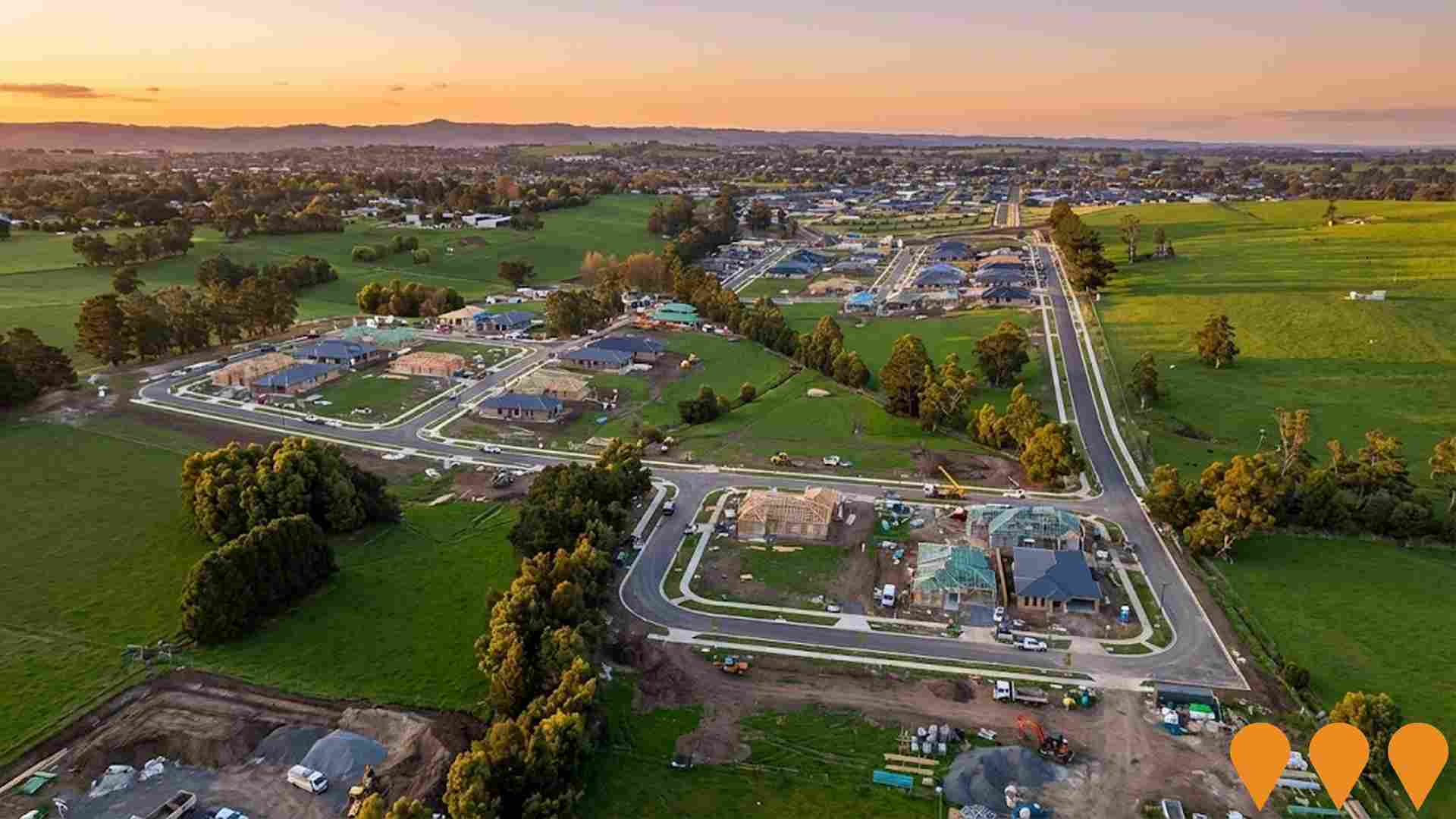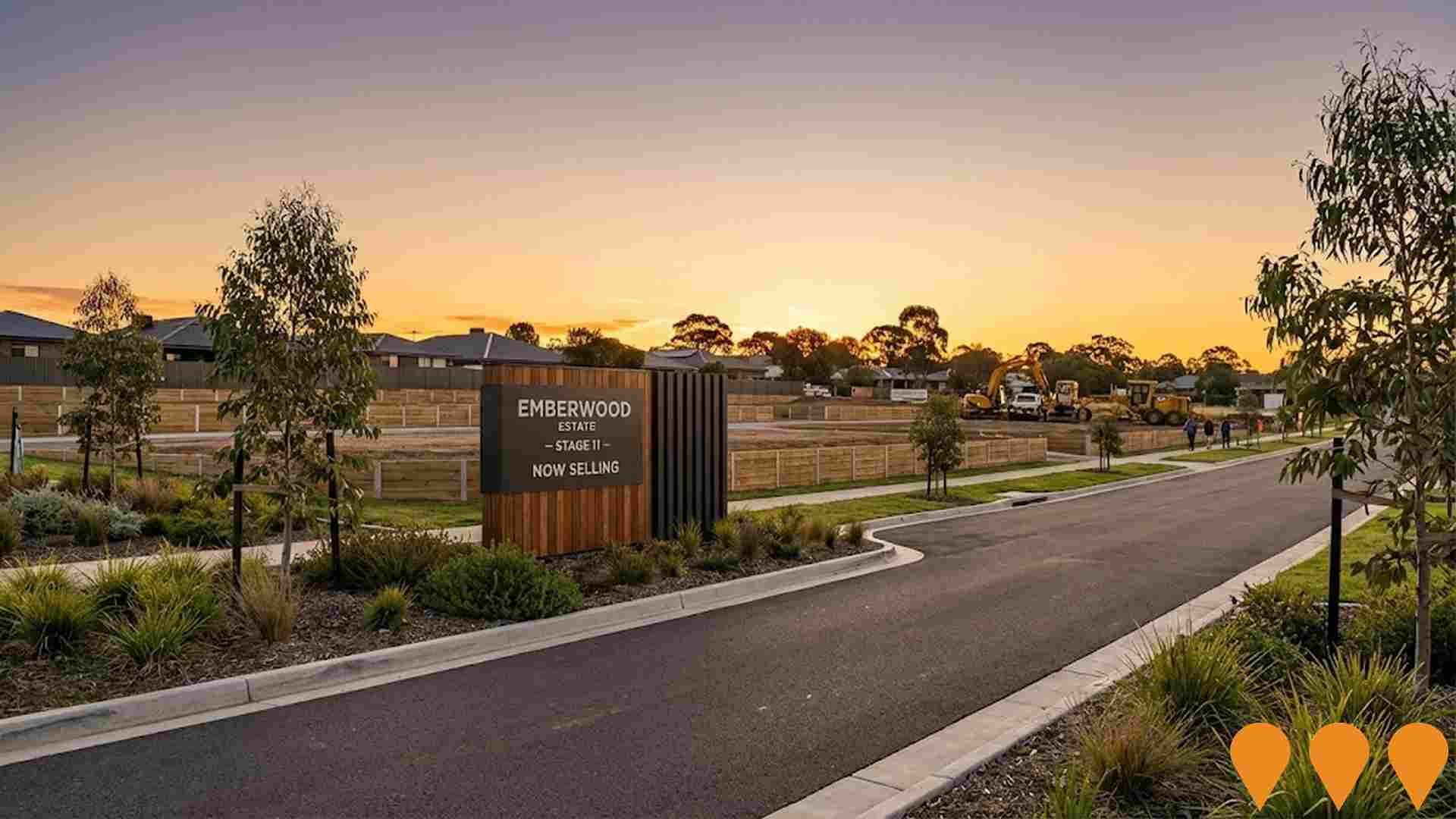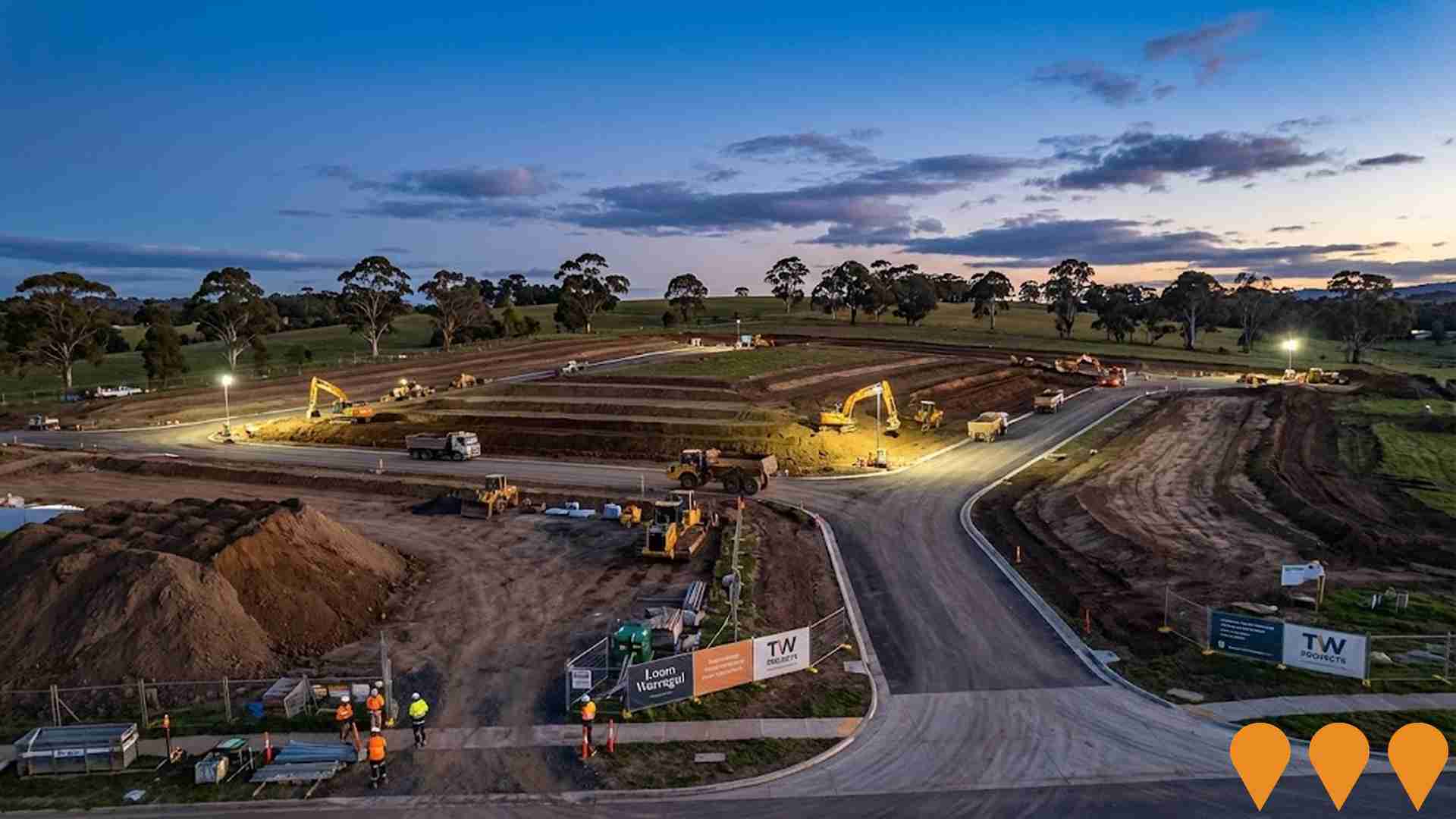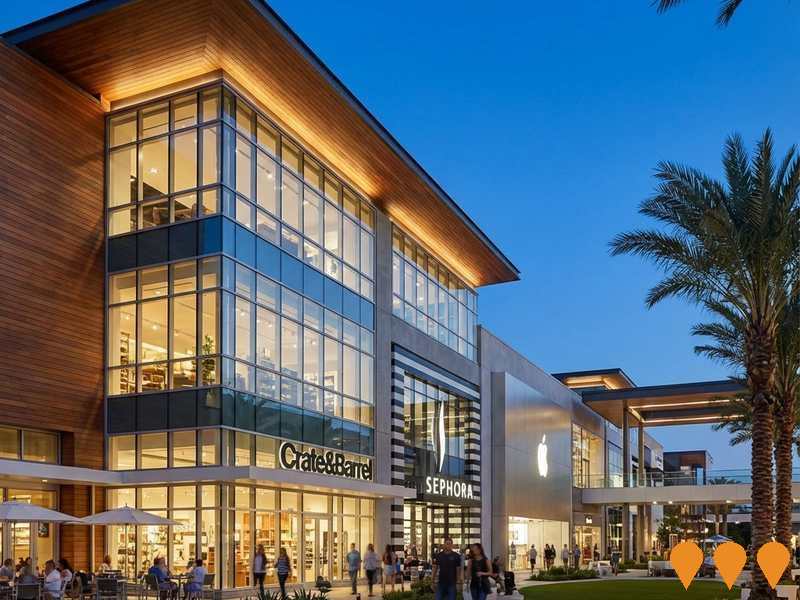Chart Color Schemes
est. as @ -- *
ABS ERP | -- people | --
2021 Census | -- people
Sales Activity
Curious about local property values? Filter the chart to assess the volume and appreciation (including resales) trends and regional comparisons, or scroll to the map below view this information at an individual property level.
Find a Recent Sale
Sales Detail
Population
Warragul lies within the top 10% of areas nationally in terms of population growth performance according to AreaSearch analysis of short and medium-term trends
Warragul's population was around 25,872 as of August 2025. This reflected an increase of 2,821 people since the 2021 Census, which reported a population of 23,051. The change was inferred from the estimated resident population of 24,957 in June 2024 and an additional 863 validated new addresses since the Census date. This resulted in a density ratio of 73 persons per square kilometer. Warragul's growth of 12.2% since the 2021 census exceeded both the non-metro area (5.5%) and its SA4 region, indicating it was a growth leader. Interstate migration contributed approximately 70.0% of overall population gains during recent periods.
AreaSearch used ABS/Geoscience Australia projections for each SA2 area released in 2024 with a base year of 2022. For areas not covered by this data, AreaSearch utilized VIC State Government's Regional/LGA projections released in 2023 with adjustments made employing a method of weighted aggregation of population growth from LGA to SA2 levels. Growth rates by age group were applied across all areas for years 2032 to 2041. Based on the latest population numbers, a significant increase is forecast for Warragul in the top quartile of regional areas nationally, with an expected increase of 7,414 persons to 2041, recording a gain of 24.9% over the 17 years.
Frequently Asked Questions - Population
Development
The level of residential development activity in Warragul was found to be higher than 90% of real estate markets across the country
Warragul granted approval for approximately 283 residential properties annually. Over the past five financial years, from FY-21 to FY-25, a total of 1,416 homes were approved, with an additional 76 approved in FY-26. On average, around 2.6 people moved to the area each year for every new home constructed during these five years.
This suggests solid demand supporting property values. The average expected construction cost value of new homes was $422,000, aligning with regional patterns. In terms of commercial development, Warragul recorded $70.6 million in approvals this financial year, indicating robust local business investment. Compared to the rest of Victoria, Warragul had slightly more development, 13.0% above the regional average per person over the five-year period, offering reasonable buyer options while sustaining existing property demand.
This level is significantly higher than the national average, reflecting strong developer interest in the area. Recent construction comprised 92.0% detached dwellings and 8.0% attached dwellings, preserving Warragul's low-density nature with an emphasis on detached housing attracting space-seeking buyers. The location had approximately 107 people per dwelling approval, indicating an expanding market. Population forecasts project Warragul will gain 6,451 residents by 2041. Given current development patterns, new housing supply should readily meet demand, presenting good conditions for buyers and potentially facilitating population growth beyond current projections.
Frequently Asked Questions - Development
Infrastructure
Warragul has emerging levels of nearby infrastructure activity, ranking in the 20thth percentile nationally
Infrastructure changes significantly influence a region's performance. AreaSearch has identified 34 projects likely impacting the area. Notable projects include Mason Street Social Housing Development, Alfred Street Mixed-Use Redevelopment, Emberwood Estate Stage 11, and Princes Highway East Upgrade - Warragul Section. The following list details projects most relevant to the area.
Professional plan users can use the search below to filter and access additional projects.
INFRASTRUCTURE SEARCH
 Denotes AI-based impression for illustrative purposes only, not to be taken as definitive under any circumstances. Please follow links and conduct other investigations from the project's source for actual imagery. Developers and project owners wishing us to use original imagery please Contact Us and we will do so.
Denotes AI-based impression for illustrative purposes only, not to be taken as definitive under any circumstances. Please follow links and conduct other investigations from the project's source for actual imagery. Developers and project owners wishing us to use original imagery please Contact Us and we will do so.
Frequently Asked Questions - Infrastructure
Warragul and Drouin Precinct Structure Plan Implementation
Implementation of the Warragul and Drouin Precinct Structure Plan to guide future urban development and infrastructure delivery across both townships. Provides framework for sustainable growth and development coordination.

Alfred Street Mixed-Use Redevelopment
Transformative mixed-use redevelopment spanning 10,083m2 across three titles featuring a boutique hotel, vibrant retail and dining hub, and activated public spaces designed to enrich Warragul's cultural and economic landscape. The development aims to blend modern architecture with local heritage, creating a destination hub that fosters community engagement and supports economic growth.

Mason Street Social Housing Development
$16.5 million, 51-unit social housing development featuring one, two and three-bedroom apartments across two four-storey buildings. Part of Victorian Government's $5.3 billion Big Housing Build. Architecturally designed by Freadman White with sustainable features including 7 Star NatHERS ratings, Green Star certification, and Livable Housing Australia Silver Level. Includes basement, office, multi-purpose space, 38 car parks and 56 bicycle parks. Currently under construction as of February 2025.

147 Dollarburn Road Residential Development
26.25 hectare approved residential subdivision within Warragul PSP featuring 114 residential lots, neighbourhood parks, sporting reserves, and farmland. Connected via proposed street through future government primary school to Waterford Rise Estate and Warragul township. Located within Urban Growth Boundary with proximity to future West Gippsland Hospital.

Princes Highway East Upgrade - Warragul Section
Upgrade of the Princes Highway east of Warragul to improve traffic flow, safety, and capacity for future growth. Part of broader regional infrastructure improvements.

Emberwood Estate - Stage 11
Stage 11 of the ongoing Emberwood Estate residential development, featuring 24 lots that are benched, retained, and fenced. Part of a 330-lot community with generous parklands, playground areas, and lots ranging from 500m2 to over 1000m2.

Warragul CBD Streetscape Project - Queen Street Final Stage
The ninth and final stage of the Warragul CBD Streetscape Project, featuring renewal of the Queen/Mason Street roundabout, replacement of five elm trees, improved footpath accessibility, kerb outstands and refuge islands at Queen Street and Gladstone Street intersection, new line-marking including bike lanes, new landscaping, and replacement of the old public toilet block with a modern facility. The project aims to improve pedestrian and traffic safety, accessibility, and traffic flow in Warragul's CBD.

Loom Warragul
TW Projects is delivering Loom Warragul, a masterplanned community of around 200 residential lots on a circa 16 ha site in Warragul. Sales office open and early civil works/roadworks underway; lots marketed for staged release.

Employment
The labour market in Warragul demonstrates typical performance when compared to similar areas across Australia
Warragul's workforce is skilled with essential services well represented. The unemployment rate in June 2025 was 2.8%.
There were 12,253 residents employed, which was 1.0% below the Rest of Vic.'s rate of 3.8%. Workforce participation was 60.0%, compared to Rest of Vic.'s 57.4%. Key industries for employment were health care & social assistance, construction, and education & training. Construction had an employment share 1.2 times the regional level.
Accommodation & food services had a lower representation at 5.3% compared to Rest of Vic.'s 6.9%. Many residents commute elsewhere for work based on Census data comparison. Between June 2024 and June 2025, Warragul's labour force decreased by 0.7%, employment decreased by 1.2%, leading to an unemployment rate rise of 0.5 percentage points. Rest of Vic.'s employment declined by 0.9% with a labour force decline of 0.4%, resulting in a 0.4 percentage point rise in unemployment rate. Jobs and Skills Australia's national employment forecasts from May 2025 project national employment growth of 6.6% over five years and 13.7% over ten years. Applying these projections to Warragul's employment mix suggests local growth of approximately 6.3% over five years and 13.3% over ten years, based on simple weighting extrapolation for illustrative purposes only.
Frequently Asked Questions - Employment
Income
The area's income profile falls below national averages based on AreaSearch analysis
According to AreaSearch's aggregation of ATO data released for financial year 2022, Warragul had a median taxpayer income of $50,583 and an average income of $63,595. These figures are slightly below the national average. In comparison, Rest of Vic had median and average incomes of $48,741 and $60,693 respectively. Based on Wage Price Index growth of 12.16% from financial year 2022 to September 2025, estimated current incomes are approximately $56,734 (median) and $71,328 (average). According to the 2021 Census, household, family, and personal incomes in Warragul rank modestly, between the 40th and 41st percentiles. Income distribution data shows that 32.9% of Warragul's population (8,511 individuals) fall within the $1,500 - $2,999 income range, similar to regional levels where 30.3% occupy this bracket. After housing expenses, 86.4% of income remains for other expenses. The area's SEIFA income ranking places it in the 5th decile.
Frequently Asked Questions - Income
Housing
Warragul is characterized by a predominantly suburban housing profile, with a higher proportion of rental properties than the broader region
Warragul's dwelling structure, as per the latest Census, consisted of 89.0% houses and 10.9% other dwellings (semi-detached, apartments, 'other' dwellings). In comparison, Non-Metro Vic.'s dwelling structure was 91.6% houses and 8.4% other dwellings. Home ownership in Warragul stood at 39.8%, with mortgaged dwellings at 38.8% and rented ones at 21.5%. The median monthly mortgage repayment in the area was $1,647, while the median weekly rent figure was recorded as $320. Nationally, Warragul's median monthly mortgage repayments were lower than the Australian average of $1,863, and rents were substantially below the national figure of $375.
Frequently Asked Questions - Housing
Household Composition
Warragul has a typical household mix, with a fairly typical median household size
Family households account for 72.1 percent of all households, including 30.1 percent couples with children, 30.4 percent couples without children, and 10.8 percent single parent families. Non-family households constitute the remaining 27.9 percent, with lone person households at 25.7 percent and group households comprising 2.1 percent of the total. The median household size is 2.5 people, which aligns with the average for the Rest of Vic.
Frequently Asked Questions - Households
Local Schools & Education
Educational attainment in Warragul aligns closely with national averages, showing typical qualification patterns and performance metrics
The area's university qualification rate is 23.2%, significantly lower than Victoria's average of 33.4%. Bachelor degrees are the most common at 15.3%, followed by postgraduate qualifications (4.4%) and graduate diplomas (3.5%). Vocational credentials are prevalent, with 39.0% of residents aged 15+ holding them, including advanced diplomas (11.8%) and certificates (27.2%). Educational participation is high at 28.1%, comprising 9.8% in primary, 8.4% in secondary, and 3.7% in tertiary education.
Sixteen schools serve 5,498 students, with typical Australian school conditions (ICSEA: 1011) offering balanced educational opportunities. The educational mix includes nine primary, four secondary, and three K-12 schools. Note: for schools with 'n/a' enrolments, please refer to the parent campus.
Frequently Asked Questions - Education
Schools Detail
Nearby Services & Amenities
Transport
Transport servicing is low compared to other areas nationally based on assessment of service frequency, route connectivity and accessibility
The public transport analysis indicates that there are 95 active transport stops operating within Warragul. These stops offer a mix of train and bus services, with a total of 31 individual routes providing 1,657 weekly passenger trips. Transport accessibility is rated as good, with residents typically located approximately 345 meters from the nearest transport stop.
Service frequency averages around 236 trips per day across all routes, equating to roughly 17 weekly trips per individual stop.
Frequently Asked Questions - Transport
Transport Stops Detail
Health
Health performance in Warragul is lower than average with common health conditions somewhat prevalent across both younger and older age cohorts
Warragul experiences significant health challenges, with common health conditions prevalent among both younger and older age groups.
Private health cover is held by approximately 51% of the total population (~13,246 people), slightly lower than the average SA2 area. Mental health issues affect 9.8% of residents, while arthritis impacts 9.6%. 63.9% of residents report no medical ailments, compared to 63.7% across Rest of Vic. The area has 20.2% of residents aged 65 and over (5,226 people). Health outcomes among seniors present challenges broadly in line with the general population's health profile.
Frequently Asked Questions - Health
Cultural Diversity
Warragul ranks below the Australian average when compared to other local markets across a number of language and cultural background related metrics
Warragul, surveyed in 2016, had a predominantly Australian-born population with 86.0% born there. Citizenship was high at 89.9%, and English-only speakers at home constituted 93.6%. Christianity was the dominant religion at 46.5%.
The 'Other' religious category was slightly overrepresented at 0.7% compared to the regional average of 0.6%. In terms of ancestry, English parents made up 31.6%, Australian 29.7%, and Irish 8.9%. Dutch ancestry was notably higher than the regional average, at 2.6% versus 2.7%. Scottish ancestry was also slightly overrepresented at 8.8% compared to 8.5%. Hungarian ancestry remained close to the regional average at 0.3%.
Frequently Asked Questions - Diversity
Age
Warragul's median age exceeds the national pattern
The median age in Warragul is 40 years, which is slightly below the Rest of Vic.'s average of 43 but above Australia's median age of 38. Compared to the Rest of Vic., Warragul has a notably higher percentage of 25-34 year-olds (14.2% locally vs. 12.9%) and a lower percentage of 65-74 year-olds (10.7%). Between the 2021 Census and now, the 35 to 44 age group has increased from 11.5% to 12.9%, while the 25 to 34 cohort has risen from 13.0% to 14.2%. Conversely, the 45 to 54 age group has decreased from 12.3% to 11.1%. By 2041, population forecasts indicate significant demographic changes in Warragul. The 25-34 age cohort is projected to expand by 1,809 people (49%), growing from 3,668 to 5,478 residents. The 75-84 age group is expected to grow modestly at 3%, adding only 48 residents.



